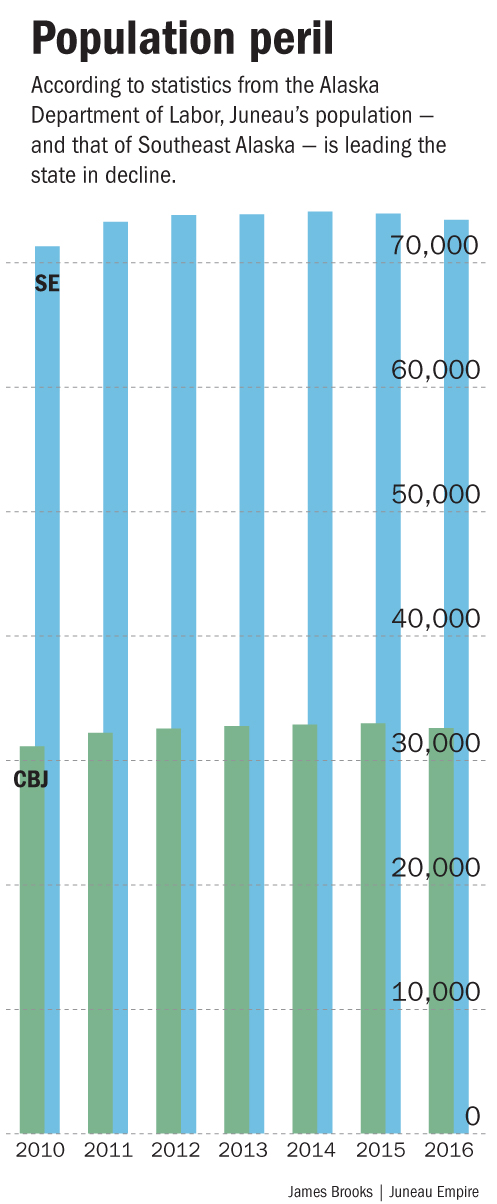If employment is the pulse of an economy, population is its blood pressure — a sign of its overall condition.
Juneau’s blood pressure is dropping, and Alaska’s isn’t doing much better.
On Thursday, the Alaska Department of Labor and Workforce Development released its annual Alaska population estimate, a figure based on Permanent Fund Dividend applications, military statistics and other figures. While Alaska gained 2,645 residents between 2015 and 2016, Juneau lost almost 400 residents in the same period. That 1.2 percent decline was the largest among Alaska’s large communities. It’s a relatively moderate decline by historical standards, however.
According to state figures, 584 more people moved away from Juneau than moved to it in 2016. New births countered some of those losses, resulting in a net loss of 398 people.
The same thing happened statewide. Alaska had 4,290 more departures than arrivals between 2015 and 2016, but because there were more births than deaths, the state actually gained population. Alaska now has 739,828 people, its most ever.
Juneau’s population of 32,739 is now roughly the same as it was in 2012.
“It’s the fourth year in a row of a pretty big net migration loss,” said state demographer Eddie Hunsinger, speaking about both Alaska and Juneau in particular. “It is another year of net migration losses for the state and for Juneau.”
Alaska (and Juneau) always have large numbers of people moving into and out of the area each year. About 8 percent of Juneau’s population is on the move in any given year. Generally, the “churn” is about equal or slightly positive — about as many people move into Juneau as move away.
“Generally we lose some folks right after high school as they go off to college and new opportunities — military service — but then we gain even more,” Hunsinger said.
In other words, the state might lose a lot of 19-year-olds, but it gains a lot of people in their 20s and 30s. As people age into their 40s, they’re more likely to move away.
Between 2015 and 2016, the state figures show fewer people in their 20s coming to Alaska, and Juneau in particular.
The capital city now has more people between ages 40-65 than it does between ages 15-40. The city’s median age, 38, is now tied for the highest it’s ever been.
“We have a huge amount of Baby Boomers,” said state economist Conor Bell, who specializes in Southeast Alaska.
Bell said the decline found by Hunsinger might not be cause for significant alarm. It could simply be a return to the slow decline Juneau had been seeing before the Great Recession.
Because Alaska’s economy remained strong during that recession, Alaska saw a surge in immigration. Now, with the reverse true, it’s possible that a gradual decline, not the population plateau of the past four years, was Juneau’s norm.
“It’s not a huge change; I don’t think it’s anything that’s truly worrisome,” Bell said. “Right now, I think the employment figures are more troubling than the demographic data.”
Those employment figures show Juneau’s economy shedding jobs, and the unemployment rate has been rising slowly for the past year and a half.
“It’s not just losing the state jobs,” said Meilani Schijvens of Rain Coast Data, a private firm, “but also the trickle-down effect of those positions.”
In January, the Department of Labor predicted that Southeast Alaska will lose 600 jobs in the coming year — most in Juneau. The state has already cut several hundred positions in Juneau, but many of those positions were cut by early retirements, and those retired employees still live in the capital city.
It’s difficult, Bell said, to determine whether those retirees are staying in Juneau or leaving, and how much of the city’s population decline is attributable to that.
Regardless, Schijvens said, lower population means fewer people spending money in local stores.
“It’s been so fun since about 2008 to write about the Southeast economy, and in 2015 it was kind of flat but still OK,” she said. “Now, my whole job is going to be a lot less exciting to write.”

